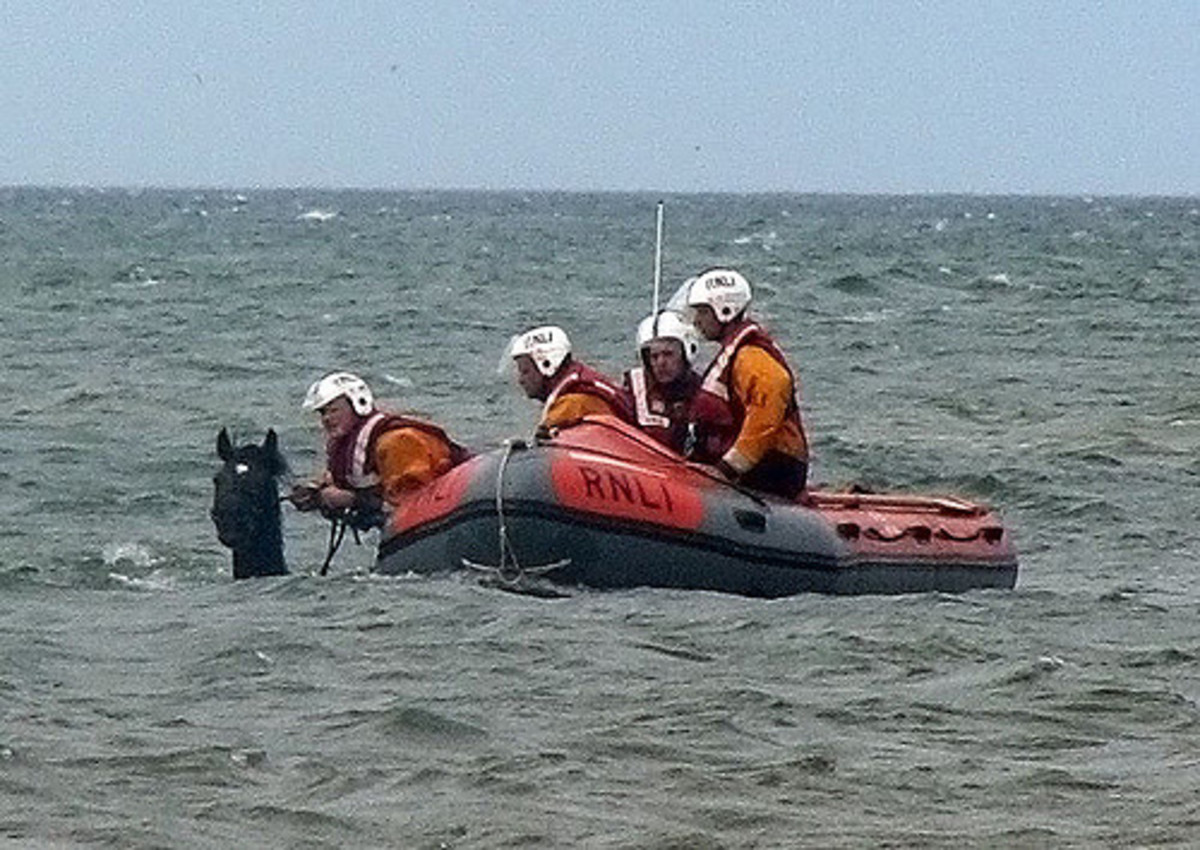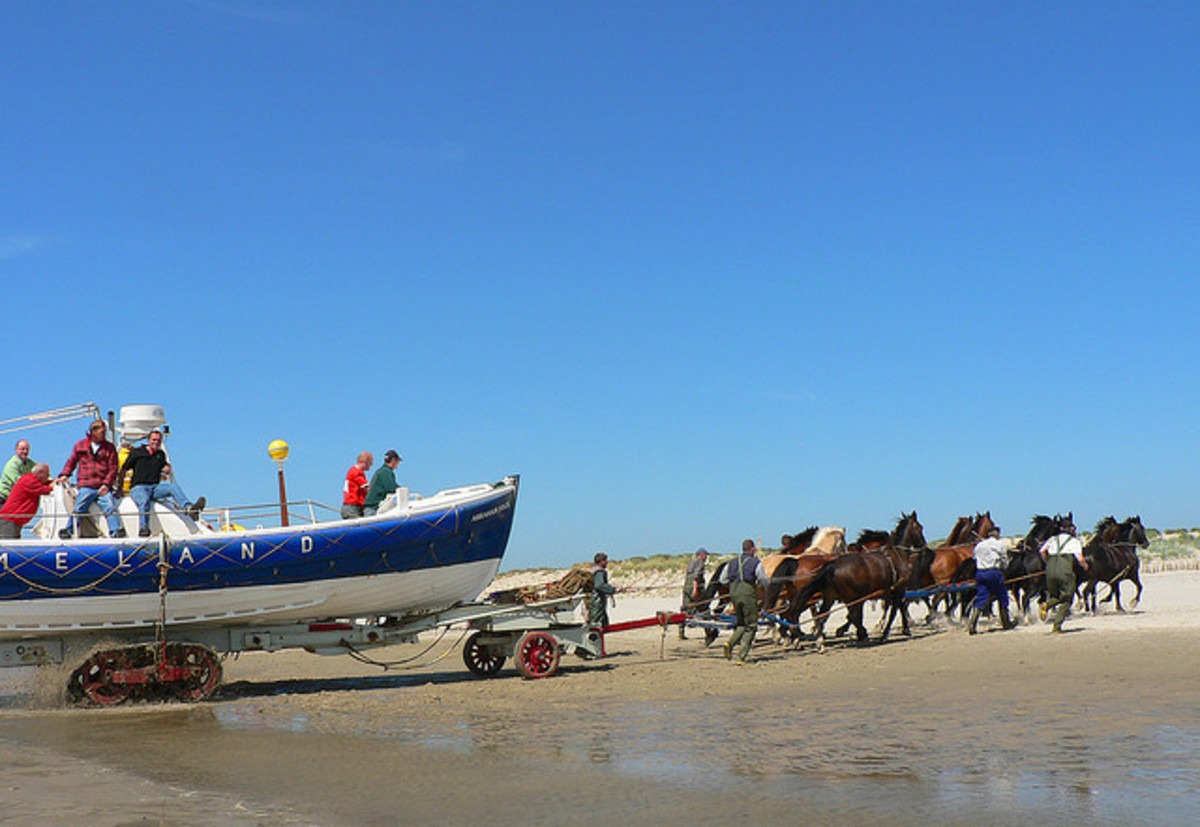Ride to the Rescue: Saving the Lives of Horses, and Horses Who Saved Lives
- March 10, 2017
- ⎯ Fran Jurga
[VIDEOSINGLE type=”youtube” keyid=”mg6GpSFQl-c”, width=”560″, height=”344″]
You simply have to see this. In Wales, a volunteer life saving crew from Cardigan Lifesaving Station, armed with a helmet cam, a halter and a leadline,? dove in to save a stranded Welsh Mountain Pony after it fell down a cliff in a remote cove amidst a rushing outbound tide.
The goal was to get a halter on the unhandled pony, who appeared nonetheworse for her fall, and swim her behind the boat to a safe, shallow beach where she could be transported.
In other words: halter-break a mare in the water and immediately lead her by swimming her next to a bright orange inflatable boat with a rumbling outboard motor and a crew aboard.
Sure, every unbroken, unhandled young mare will do that.
A transcription of the crew’s process is posted on Horse and Hound’s web site.
I thought it was amazing that someone in the boat knew how to put a halter on.


Things you may not know about me: I share my office with our town’s harbormaster, and the building next door is one of the major US Coast Guard stations on this stretch of the New England shoreline. My day is punctuated by sirens and, every once in a while, the comings and goings of rescue helicopters and ambulances.
Another thing you may not know about me: I am fortunate to live in a community that opens its beaches to horses and you can gallop forever–except during the summer months.
After watching this video, I have to wonder what would happen if a pony or horse got loose on the beach here and swam out to sea. Some of the beaches, particularly where the estuaries form such great gallopable barrier beaches, have dangerous tidal rips. What would Coast Guard Station Gloucester do if they got a call to go after a horse in the surf?

The US Coast Guard is part of the U.S. Department of Homeland Security and, as such, is armed with every imaginable electronic device and system. But when it comes to a real rescue, it may come down to the incredible rescue swimming skills and bravery of the crew that comes to help you.
Would they know one end of the halter from the other?
Compare the Department of Homeland Security’s resources for the US Coast Guard with the all-volunteer staff at Cardigan Lifeboat Station on the west coast of Wales. The station even has an all-female life boat rescue crew. But they’re all volunteers and they depend on donations from the public.
If you’ve ever seen the PBS/BBC show Doc Martin, you know that the receptionist is a volunteer for the little fishing village’s lifeboat–an accomplishment that makes her very proud, and that wasn’t easy for her to achieve. Martin Clunes, the actor who plays Doc Martin, is president of the British Horse Society, by the way. I keep waiting for horses to be featured in that show.
The key point is this: these lifesavers overseas are volunteers. They routinely risk their lives to rescue people–and even ponies. ?If you’re ever in a seaside town’s pub in the UK or Ireland you might see the little fundraising boats set out on the bar to gather donations.
Every once in a while, stories about horses swept out to sea or marooned by the tide come to light, usually in the UK or Holland. It’s interesting to me, since I have been researching the opposite: I’m interested in the use of horses in lifesaving. That’s right, horses were lifesavers. Horses pulled the surfboats in and out of the water, lived in little stables next to lighthouses, and generally served much as firehorses did, but with much less recorded history. They seemed to have faded from use after World War I but some remote lighthouses or rescue stations kept them on.
Horses were standard lifesaving equipment. During World War II, the Coast Guard acquired thousands of horses that they used to patrol the beaches to guard against German U-boat landings (East Coast) or Japanese submarines (West Coast). The Coast Guard even had its own farriers.
If anyone knows about the history of lifesaving horses anywhere in the world, please contact me. But whether lifesavers are in the US Coast Guard or volunteers in some remote harbor in Wales, the skills that they use and the bravery that they display is worthy of our thanks and support and respect. If there is anything you can do to help your local rescue crews–by land or by sea–learn more about horses and how to handle them in emergencies, your time or money will be a good investment.









